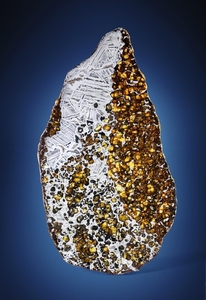EXTRATERRESTRIAL GEMSTONES IN METALLIC MATRIX — COMPLETE SLICE OF A SEYMCHAN METEORITE, Pallasite – PMG Magadan District, Russia (62°54’ N, 152°26’ E)
A complete slice of a meteorite with extraterrestrial gems. Tear-drop in shape, it features a large field of olivine on one side with smaller clasts near the base. The flow of molten iron-nickel through the olivine components is readily discerned. The metallic matrix has been etched to reveal its crystalline lattice. This sample originates from the interface of the molten iron core and stony mantle of an asteroid that shattered apart. Modern fashioning.
355 x 184 x 3 mm. (14 x 7¼ x ⅛ in.) and 987.8 g. (2.2 lbs.)
With a seam of metal coursing along its length and abundant olivine and peridot crystals, this is a select specimen of a pallasitic meteorite. Pallasites are not only rare, representing less than 0.2% of all known meteorites, they are also widely considered the most beautiful extraterrestrial substance known. Like all pallasitic meteorites, Seymchan originated from the core-mantle boundary of an asteroid that was blasted apart by an enormously energetic collision. The crystals seen here are the result of small chunks of the stony mantle becoming suspended in the molten metal of an asteroid’s iron-nickel core. Cut and polished, the lustrous metallic matrix features crystals of gleaming olivine ranging in hues from emerald to amber. The prominent latticework referred to as a Widmanstätten pattern is indicative of a slow cooling rate that provided sufficient time — millions of years — for the two primary alloys to orient into their crystalline structure. This pattern is diagnostic in the identification of an iron meteorite and different meteorites have different patterns (see lot 1 and 34). It was in the 1960s that the first masses of Seymchan were found in a streambed in a part of Siberia made infamous as the remote location of Stalin’s gulags. Identified as meteorites, they were named Seymchan for a nearby town. Unlike most pallasites, the dispersion of olivine crystals in Seymchan is extremely heterogeneous. Some specimens are olivine rich and some are olivine poor; some specimens have no olivine whatsoever. The example now offered boasts an aesthetic array of olivine and its gem-quality counterpart, peridot, the birthstone of August.
Christie's would like to thank Dr. Alan E. Rubin at the Institute of Geophysics and Planetary Physics, University of California, Los Angeles for his assistance in preparing this catalog note.
View it on
Sale price
Estimate
Time, Location
Auction House
A complete slice of a meteorite with extraterrestrial gems. Tear-drop in shape, it features a large field of olivine on one side with smaller clasts near the base. The flow of molten iron-nickel through the olivine components is readily discerned. The metallic matrix has been etched to reveal its crystalline lattice. This sample originates from the interface of the molten iron core and stony mantle of an asteroid that shattered apart. Modern fashioning.
355 x 184 x 3 mm. (14 x 7¼ x ⅛ in.) and 987.8 g. (2.2 lbs.)
With a seam of metal coursing along its length and abundant olivine and peridot crystals, this is a select specimen of a pallasitic meteorite. Pallasites are not only rare, representing less than 0.2% of all known meteorites, they are also widely considered the most beautiful extraterrestrial substance known. Like all pallasitic meteorites, Seymchan originated from the core-mantle boundary of an asteroid that was blasted apart by an enormously energetic collision. The crystals seen here are the result of small chunks of the stony mantle becoming suspended in the molten metal of an asteroid’s iron-nickel core. Cut and polished, the lustrous metallic matrix features crystals of gleaming olivine ranging in hues from emerald to amber. The prominent latticework referred to as a Widmanstätten pattern is indicative of a slow cooling rate that provided sufficient time — millions of years — for the two primary alloys to orient into their crystalline structure. This pattern is diagnostic in the identification of an iron meteorite and different meteorites have different patterns (see lot 1 and 34). It was in the 1960s that the first masses of Seymchan were found in a streambed in a part of Siberia made infamous as the remote location of Stalin’s gulags. Identified as meteorites, they were named Seymchan for a nearby town. Unlike most pallasites, the dispersion of olivine crystals in Seymchan is extremely heterogeneous. Some specimens are olivine rich and some are olivine poor; some specimens have no olivine whatsoever. The example now offered boasts an aesthetic array of olivine and its gem-quality counterpart, peridot, the birthstone of August.
Christie's would like to thank Dr. Alan E. Rubin at the Institute of Geophysics and Planetary Physics, University of California, Los Angeles for his assistance in preparing this catalog note.



